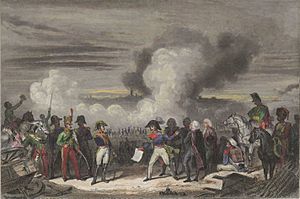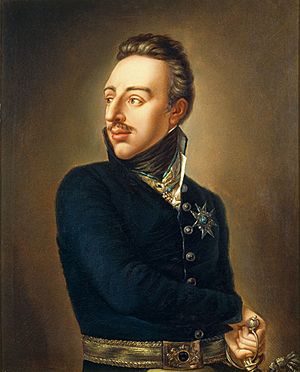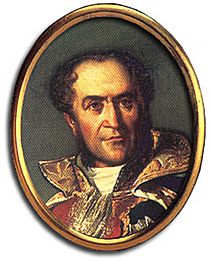Siege of Stralsund (1807) facts for kids
Quick facts for kids Siege of Stralsund |
|||||||||
|---|---|---|---|---|---|---|---|---|---|
| Part of the Franco-Swedish War | |||||||||
 Prise de Stralsund, by Hippolyte Lecomte |
|||||||||
|
|||||||||
| Belligerents | |||||||||
| Commanders and leaders | |||||||||
| Strength | |||||||||
| 40,000 | 15,000 500 guns |
||||||||
| Casualties and losses | |||||||||
| 998 killed, wounded or captured | Unknown | ||||||||
The Siege of Stralsund was a big battle that happened from July 24 to August 24, 1807. During this time, soldiers from the First French Empire tried twice to take the port city of Stralsund from the Swedish army. The Swedish army, led by Lieutenant General Hans Henric von Essen, had about 15,000 soldiers.
Earlier that year, a French commander named Marshal Mortier had surrounded the city for two months. A "marshal" was a very high-ranking military leader. He had to leave for another battle, and the Swedes pushed back the smaller French force. When Marshal Mortier returned, he pushed the Swedish troops back again. Both sides then agreed to a temporary stop in fighting, called an armistice.
However, King Gustav IV Adolf of Sweden of Sweden later said he would not follow the armistice. So, another French Marshal, Guillaume Brune, led a huge army of 40,000 French, German, Spanish, Italian, and Dutch soldiers against Stralsund. The Swedish army was greatly outnumbered. They had to leave the important Baltic Sea port of Stralsund to the French and their allies. This event was part of the War of the Fourth Coalition, which was part of the bigger Napoleonic Wars. Because of this battle, Sweden also lost the nearby island of Rügen.
Contents
Why the Siege Happened
Sweden had controlled Stralsund and the surrounding area, called Swedish Pomerania, for a long time. This control started after battles and treaties in the 1600s.
When Napoleon Bonaparte began expanding his empire across Europe, Sweden first tried to stay neutral. But in 1805, King Gustav IV Adolf of Sweden joined the fight against Napoleon. He mainly wanted to take Norway from Napoleon's ally, Denmark. However, his plans for Norway did not work out.
The First Blockade
Stralsund was a port city in Swedish Pomerania. It was defended by the Swedish governor, Hans von Essen. On January 28, French forces led by Marshal Mortier crossed the Peene River. They wanted to surround Stralsund and stop supplies from getting in or out. This is called a blockade.
For the next two months, there were many small fights. The French tried to make their blockade stronger. But they did not control the island of Rügen, so the Swedes could still get supplies by sea. Swedish gunboats also bothered the French. During this time, some French soldiers were sent to fight in Poland. They were replaced by soldiers from the Kingdom of Holland.
On March 29, Marshal Mortier was ordered to leave some troops to continue the blockade. He had to go help with another siege in a different city. After Mortier left, the Swedish forces, led by Essen, attacked the French. They pushed the French back. The French commander, General Grandjean, had to retreat.
Mortier then came back. By April 13, he had gathered about 12,000 to 13,000 men. This was about the same number as the Swedish army. Mortier began pushing Essen's troops back again. On April 16, Mortier defeated the Swedes in a battle. The next day, Essen retreated to the north side of the Peene River.
The Truce
Starting on April 18, the French and Swedish armies agreed to a truce. Napoleon wanted Mortier's soldiers to fight against the Russians and Prussians. So, he allowed Mortier to make a deal with the Swedes. The Swedes were also unhappy because England had not given them much support.
By April 29, the terms of the truce were set. The Swedes agreed to stay on the north side of the Peene River. They also gave up two islands at the mouth of the Oder River. They promised not to help the Prussians in other sieges happening at the time.
The Final Siege
King Gustav IV Adolf returned to Stralsund on May 12. He ended the truce on July 3. By this time, Sweden had lost all its allies except Great Britain. King Gustav IV Adolf strongly disliked Napoleon and did not want to make any deals with him.
On July 24, French Marshal Guillaume Brune attacked the Swedish positions on the Peene River. He took back the areas around Stralsund. Brune had about 40,000 soldiers. These included French, Dutch, Spanish, Italian, and German troops.
The Swedish army had about 15,000 defenders. They also had 500 cannons in the fortress. King Gustav IV Adolf left the city on August 20. The Swedes realized that fighting was useless against such a large army. They made their cannons unusable and burned the gun carriages. They moved their gunpowder and cannonballs to Rügen.
During this second siege, the French and their allies lost about 998 soldiers who were killed, wounded, or captured. The number of Swedish losses is not known. Stralsund and Rügen were given to France after an armistice. Stralsund was handed over on August 24, and Rügen on September 7, 1807.
On August 25, French forces attacked the fortified island of Dänholm near Rügen. They had about 1,200 men. They successfully took the island. The French lost 15 killed and 26 wounded. The Swedish defenders lost between 26 and 125 men, and between 300 and 517 were captured. The French also took eight fortress guns and six field cannons.
What Happened Next
After Sweden was forced out of northern Germany in 1807, they were attacked by Denmark-Norway and the Russian Empire in 1808. King Gustav IV Adolf was arrested in 1809 because of military problems and a lack of support. He was removed from power, and his family was sent away. Sweden also lost a third of its land in a treaty.
French control of Stralsund was briefly interrupted in May 1809. A Prussian group of soldiers took the city. But after a few days, the French recaptured it in the Battle of Stralsund. When the Napoleonic Wars ended in 1815, Stralsund and all of Swedish Pomerania became part of Prussia.
See also
- Pomerania during the Early Modern Age
- History of Pomerania (1806–1933)





